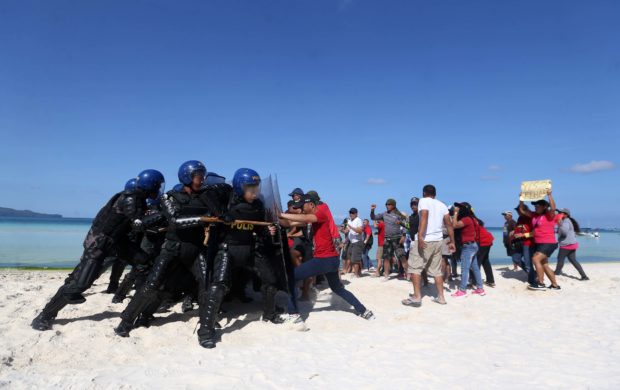
PREPARING FOR TROUBLE Aftermost of the tourists have packed up, Boracay’s white sand beaches become a ground for riot drills between policemen and “protesters’’ on Wednesday, the eve
of the island’s shutdown for a six-month cleanup. —LYN RILLON
BORACAY ISLAND, Aklan — This resort island suddenly became more affordable, as police in riot gear staged drills and workers mounted a last-ditch effort to stop its closure to tourists for up to six months.
President Rodrigo Duterte has ordered Boracay off-limits to tourists from Thursday so it can be rehabilitated, after pronouncing the 1,032-hectare island a “cesspool.”
Two days before the closure, signs showing reduced prices of goods and services were everywhere.
The D’Mall commercial complex at the heart of the long beach here had been transformed into a bagsak presyo (cut-price) center.
Along the beach, branded Boracay shirts originally priced at P199.75 were being sold at P100 per piece. Sunglasses were sold at half the previous price.
Hotels and restaurants were offering discounts on food to dispose of their stocks. Several resorts lowered their room rates to up to 50 percent. Others upgraded the accommodations of their guests for free.
It was buy-one-take-one for fruit shakes at a hotel near Boat Station 1 at the northern end of the island.
Explosions, gunfire
On the eve of the shutdown, explosions and gunfire erupted near Willy’s Rock formation.
Security forces, including those from the Navy Special Warfare Group (SWAG) and PNP Special Weapons and Tactics (SWAT), simulated a violent protest rally, bombing and hostage-taking, startling the laid-back beach community.
The exercise included a sea chase and gun battle with aerial support in a cordoned-off area.
While government officials lauded the exercise, several residents, including expatriates, decried the security measures as “overkill.”
“They’ve gone completely nuts. [Explosions], gunshots from everywhere, helicopters with machine guns hovering over the island. Is this to scare the last tourists away and intimidate the remaining residents so they will be submissive?” a resident said.
An expatriate said the massive security measures sent a negative image of the island. “Ridiculous,” another resident said.
Police officials defended the measures.
Unhampered rehab
PNP Deputy Director General Fernando Mendez Jr. said the measures were meant to ensure “continuous and unhampered” rehabilitation efforts.
The priority is to fix the drainage, sewage lines, water treatment system and the roads, and to remove easement violations on the beach and illegal structures on wetlands and forestlands.
Some residents complain they were not given a chance to comply with laws that are only now being enforced.
Canadian Allan Lieberman has called Boracay home for three decades. Despite having legal papers and permits issued by local authorities, he’s demolishing his 10-year-old cliffside resort, in anticipation of being evicted for occupying a plot that is supposed to be protected forestland.
He thinks it’s was time for him to leave anyway.
“Boracay? I hate Boracay,” he said, as a team of workers behind him took down solar panels and wooden poles. “There’s nothing of the old Boracay left. Even if restored, its soul has gone.”
Last-ditch effort
In a last-ditch effort, three private individuals—Boracay residents and workers—asked the Supreme Court to halt the closure.
“Petitioners [are] seeking relief from a blatantly oppressive governmental measure that would deprive them of their livelihood, violate their rights and cause suffering for them, their families, and thousands of other [people] living and working on the island,” the petition read.
It added that the President’s directive to keep Boracay off limits to tourists was “marked by single-handedness, arbitrariness, and the usurpation of authority vested by the Constitution in another branch.”
Presidential spokesperson Harry Roque said the Supreme Court had ruled that the government primarily owned the island, which was why it could close it to tourists in the exercise of its police power to protect the environment.
Livelihood
The closure threatens the livelihood of 17,000 hotel, restaurant and other tourism workers, plus about 11,000 construction workers.
More than 2 million tourists visited Boracay, pumping P56 billion in revenue into the Philippine economy.
Local officials are scheduled to close Boracay to tourists starting at 12:01 a.m. on Thursday “with or without” an executive order from President Duterte.
Only residents and workers with ID cards and terminal passes will be allowed to purchase boat tickets at the Caticlan port in Malay town before proceeding to Boracay.
While many residents and business owners were resigned to the island’s closure, some were facing the challenge in high spirits.
‘Boodle fight’
Owners and employees of the Sea Wind Boracay resort were set to hold a “boodle fight” on Wednesday night. In a boodle fight, people eat food on a long table with their bare hands.
“We would be with our employees because they are like family to us. And we didn’t want to be gloomy because this was also an opportunity to make Boracay better,” Ruth Tirol-Jarantilla, one of the owners, told the Inquirer.
Resort operator Hayden Bandiola said he would bring his 40 staff members to a spring resort in Antique province for a fun trip on April 28.
“Many of us will not be seeing each other for several months and I would like us to part ways in a positive note and with no ill-feelings,” he said.
Several residents, expatriates and business owners were having dinner and drinks until midnight on Thursday to mark the closure. —With reports from Marlon Ramos, Leila B. Salaverria and the wires